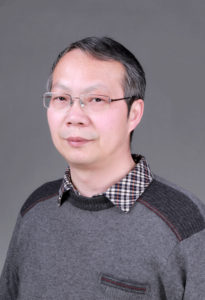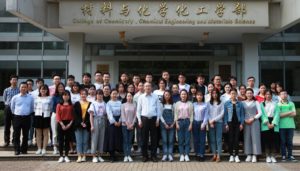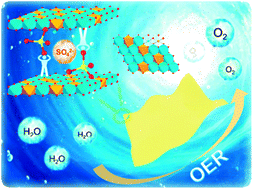We are very pleased to introduce Professor Jian-Ping Lang, the corresponding author of the paper ‘Ultrathin sulfate-intercalated NiFe-layered double hydroxide nanosheets for efficient electrocatalytic oxygen evolution‘. His article has been very well received and handpicked by our reviewers and handling editors as one of our May HOT articles. Jian-Ping was kind enough to tell us more about the work that went into this article and what he hopes to achieve in the future. You can find out more about the author and their article below and find more HOT articles in our online collection.
Meet the Author
 Jian-Ping Lang received his Ph.D. degree in 1993 from Nanjing University. During 1995-2001, he was a postdoc at Nagoya University and at Harvard University working on Mo/Fe/S chemistry related to the FeMoco structure in nitrogenases. In 2001, he returned to Soochow University and was promoted to a full Professor of the College of Chemistry, Chemical Engineering and Materials Science. He was promoted as a Chung Kong Scholar Professor by the Ministry of Education of China (2012), a fellow of the Royal Society of Chemistry (FRSC) of UK (2014), a Foreign Fellow of European Academy of Sciences (2018) and a Chair Professor of Chemistry at Soochow University (2018). His research interests cover the synthesis, structural chemistry and third-order nonlinear optical (NLO) properties of metal sulfide clusters, photochemical cycloaddition of olefinic ligands within crystalline preformed MOFs, nano-scaled MOFs and other nanomaterials for the transformation of small molecules, and so on. He has published more than 440 research papers in the journals such as Chem. Soc. Rev., JACS, Angew. Chem. Int. Ed. and applied 25 Chinese patents. Currently he is working as the vice-chairman of Academic Degree Evaluation Committee and vice-director of Academic board of Soochow University. He is also serving as the vice-chairman of Crystal Chemistry Specialized Committee of Chinese Chemical Society, a member of Inorganic Chemistry Disciplinary Committee of Chinese Chemical Society and a member of Molecular Sieve Specialized Committee of Chinese Chemical Society. He was awarded the Distinguished Young Scholar Fund by the National Natural Science Foundation, the second prizes of the Science and Technology Advancement of Jiangsu Province (2010), and Natural Science by Ministry of Education of China (2011). He is a member of International Advisory Board of Dalton Transactions (2010-date) and an Editorial Board Member of Scientific Reports of Springer Nature Limited (2015-date).
Jian-Ping Lang received his Ph.D. degree in 1993 from Nanjing University. During 1995-2001, he was a postdoc at Nagoya University and at Harvard University working on Mo/Fe/S chemistry related to the FeMoco structure in nitrogenases. In 2001, he returned to Soochow University and was promoted to a full Professor of the College of Chemistry, Chemical Engineering and Materials Science. He was promoted as a Chung Kong Scholar Professor by the Ministry of Education of China (2012), a fellow of the Royal Society of Chemistry (FRSC) of UK (2014), a Foreign Fellow of European Academy of Sciences (2018) and a Chair Professor of Chemistry at Soochow University (2018). His research interests cover the synthesis, structural chemistry and third-order nonlinear optical (NLO) properties of metal sulfide clusters, photochemical cycloaddition of olefinic ligands within crystalline preformed MOFs, nano-scaled MOFs and other nanomaterials for the transformation of small molecules, and so on. He has published more than 440 research papers in the journals such as Chem. Soc. Rev., JACS, Angew. Chem. Int. Ed. and applied 25 Chinese patents. Currently he is working as the vice-chairman of Academic Degree Evaluation Committee and vice-director of Academic board of Soochow University. He is also serving as the vice-chairman of Crystal Chemistry Specialized Committee of Chinese Chemical Society, a member of Inorganic Chemistry Disciplinary Committee of Chinese Chemical Society and a member of Molecular Sieve Specialized Committee of Chinese Chemical Society. He was awarded the Distinguished Young Scholar Fund by the National Natural Science Foundation, the second prizes of the Science and Technology Advancement of Jiangsu Province (2010), and Natural Science by Ministry of Education of China (2011). He is a member of International Advisory Board of Dalton Transactions (2010-date) and an Editorial Board Member of Scientific Reports of Springer Nature Limited (2015-date).
Could you briefly explain the focus of your article to the non-specialist (in one or two sentences only) and why it is of current interest?
Our article introduced a facile and promising method for the synthesis and modification of ultrathin NiFe-layered double hydroxides (LDHs) as the highly efficient oxygen evolution reaction (OER) electrocatalysts.
How big an impact could your results potentially have?
Compared with traditional synthetic methods, our results demonstrated that ultrathin NiFe-LDHs can be directly prepared without adding additive (alkali, surfactant), and even large-scale synthesis of such LDHs can also be achieved. Moreover, we revealed the influence of solvent water and sulfate ion on the morphology and electrocatalytic performance of our NiFe-LDHs through a series of detailed structural and electrochemical characterization, which provided a new insight into the design and preparation of LDHs and other 2D lamellar materials.
Could you explain the motivation behind this study?
•Current commercial OER electrocatalysts mostly focus on precious metal materials, but the scarcity and high cost greatly hinder their large-scale synthesis and application.
•Although the reported NiFe-LDHs possess good performance for OER, the facile and efficient large-scale synthesis of ultrathin nanosheets with uniform morphology represents a highly challenging job.
•Considering the negative effect of additives (alkali, surfactant) on the active sites of the electrocatalyst, our initial design idea was direct control of the morphology of NiFe-LDHs through solvents (H2O) or anions (SO42-), thereby ensuring the cleanliness of the as-prepared catalyst surface.
In your opinion, what are the key design considerations for your study?
Well, to conduct such a study, we must precisely regulate the reaction conditions of NiFe-LDHs. This includes the type and ratio of the metal salt selected, the combination of mixed solvents, reaction temperature and time, pH, etc. The whole reaction process involves multiple variables, and thus the key to design considerations is to find the optimal synthesis conditions of ultrathin NiFe-LDHs nanosheets.
Which part of the work towards this paper proved to be most challenging?
Overall, except for the fine characterization of the electrocatalyst, we consider the study of catalytic mechanisms to be the most challenging, especially the in-situ changes in the structure of NiFe-LDHs during the catalytic process and the determination of the active sites.
What aspect of your work are you most excited about at the moment?
We have acquired a simple and promising method for synthesizing ultrathin LDHs nanosheets. In particular, we are very excited about the universality of the synthesis of different two-dimensional materials that are widely used in the field of energy storage and conversion.
What is the next step? What work is planned?
Regarding the work related to the present article, the first thing we are going to do is to explore specific reaction process, focusing on the corresponding relationship between structure and performance of the electrocatalysts. Besides, we are currently examining the universality of this synthetic strategy, such as the synthesis of ultrathin MOFs materials.
Ultrathin sulfate-intercalated NiFe-layered double hydroxide nanosheets for efficient electrocatalytic oxygen evolution
Xiao-Xiao Jiang, Jiang-Yan Xue, Zhong-Yin Zhao, Cong Li, Fei-Long Li, Chen Cao, Zheng Niu, Hong-Wei Gu and Jian-Ping Lang
RSC Adv., 2020,10, 12145-12150
DOI: 10.1039/D0RA00845A, Paper
 Submit to RSC Advances today! Check out our author guidelines for information on our article types or find out more about the advantages of publishing in a Royal Society of Chemistry journal.
Submit to RSC Advances today! Check out our author guidelines for information on our article types or find out more about the advantages of publishing in a Royal Society of Chemistry journal.
Keep up to date with our latest HOT articles, Reviews, Collections & more by following us on Twitter. You can also keep informed by signing up to our E-Alerts.












